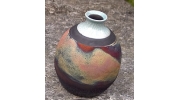Raku, Old and New Tradition - Supporting the Organization of Japanese Ceramic Courses
Project location: Italy, Todi
Project start date: August 2009 -
Project end date: October 2009
Project number: 2009-34
Beneficiary: Associazione culturale A.M.I.N.A.
The course was held in two phases: during the first phase refractory clay was shaped, after reading some books and catalogs of contemporary artists working with clay. The drying of objects was done very slowly and away from drafts, to avoid micro-fractures during drying, which would have caused cracks during firing.
After drying there was the first firing of the objects, which is a very delicate process because too rapid a rise in temperature could cause the rupture of the object. In fact, the natural drying does not completely eliminate the water contained in the clay and it is therefore necessary to gradually increase the heat in the oven to allow moisture to evaporate.
The cooking temperature varies between 920 ° and 1000 ° C depending on the material used. The temperature increases of about 2 ° C per minute, with several breaks, to reach a temperature of 280 ° C approx. This first part takes about 2 ½ hours, after which you can increase the temperature to 900 ° C. Once this temperature is reached, it must be maintained for a period ranging from 10 to 20 minutes depending on the size of the object.
The second phase, which occurred a week after the first, was the decoration of the works by the participants, with special glazes and brushes. The difficulty in choosing colors is due to the fact that the glaze before being fired has a different tone. It is very difficult to combine colors properly and place the desired thickness of enamel.
After the decoration came the "reduction", which is the most exciting and spectacular time of processing, where the surface becomes full of shades, metallic glitter and luster. After removal from the oven of the glazed object, the piece was subjected to reducing by placing it immediately in a container partially filled with sawdust or other combustible material like dry leaves, paper, etc. The container was sealed and allowed to cool.
The participants were delighted with the extraction of objects. As the extraction temperature is around 1000 ° C, they were able to touch their work only after cooling in running water, during which they could notice that the object has its own iridescence, and a typical Raku pottery crackle.
From painting to the final object only two hours go by: a short wait, which allowed participants to achieve a feeling of happiness equal to that of a genius who miraculously achieves his desires.
Thanks to this course, several Italian and foreign intellectuals, established and emerging, have created new synergies that will lead to major new projects in the future for the Association AMINA, opening up new prospects in a globalized market for contemporary art.
For younger participants the experience was particularly amusing, because, around the tower, surrounded by a wood bordered by the river Tiber, there is a farm with an organic garden, an orchard, a pond and pets. In addition, children and adolescents, dealing with operators and with their parents were very surprised to find that the results of their efforts have been equal or even better than the works of some masters of the twentieth century. Children's products are in fact generally very expressive, lively and with harmonious colors, shapes and freshness. The two teachers who led the course are very close to the theoretical positions of Rudolf Steiner, who believed that art (painting, sculpture, music, dance, singing) can educate a child better than other subjects like mathematics and grammar.
After two months from the end of the course during the Christmas holidays, the association AMINA has exhibited all the ceramics in an exhibition area of a colonial-style house in Todi, combining the event with the presentation of cashmere clothing for children by a renowned fashion firm in Umbria. The evening was also enlivened by live music and tasting of local wines and organic food. The event was published by two major newspapers in Umbria which have pointed out that important Italian artists of contemporary art have also participated in the course.
This exhibition has shown that the ancient craft traditions attract the attention of intellectuals, politicians and experts, and also the curiosity of children, who attended to enjoy the surprise of seeing their works displayed alongside those of adults on famous designer-furniture of the twentieth century.
In 2011 the Association A.M.I.N.A. will create a catalog of works created by participants to the 2010 course, to give visibility to the initiative through the free distribution of the catalog in schools and public offices in major cities of Umbria. Inside, the catalog will contain an article by a journalist, poet and art critic from Umbria. The catalog will be published by a publishing house specializing in art.





